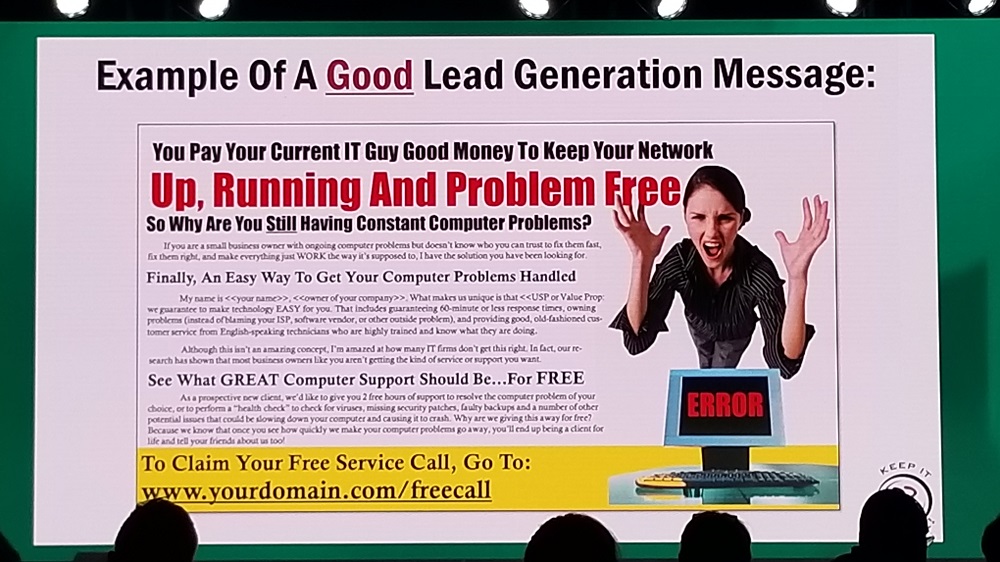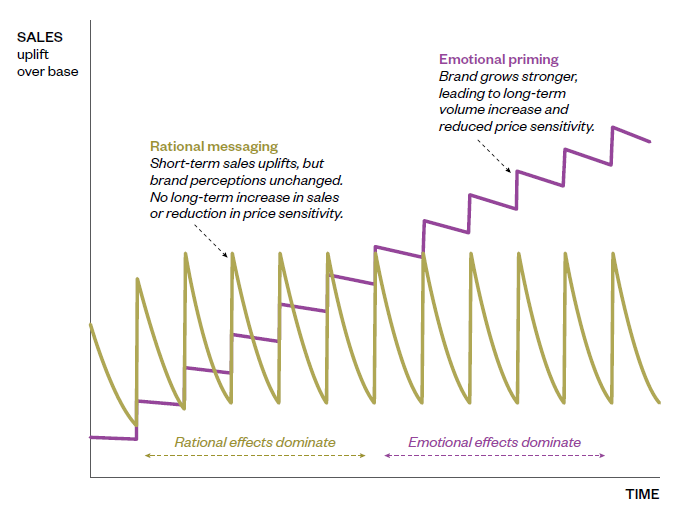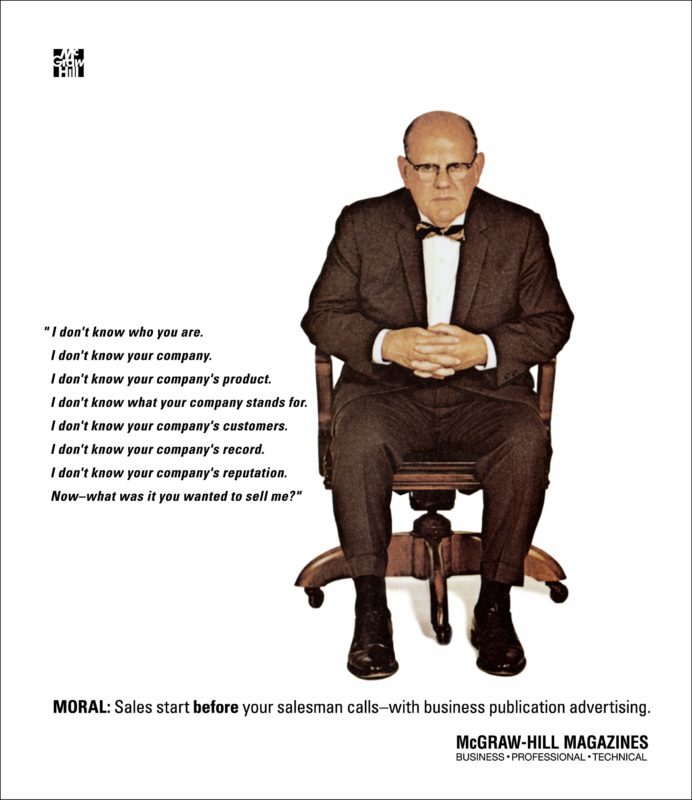Robin Robins is a leading marketing consultant for small managed service providers (MSPs) and IT services companies. She regularly runs workshops for vendors and at channel conferences and claims 8,000-plus MSP and IT services clients over the past 17 years. As a result, she says, “We have more documented success stories than any other marketing consultant in this industry, period.”
Since I, too, work with channel partners and other kinds of companies (from MIT startups to multi-billion dollar enterprises) to improve their marketing and business results, I figured I could learn a thing or two from her. So I recently sat in on her three-hour workshop at an industry conference.
She provides a lot of value to the small companies that don’t have a repeatable sales and marketing process. And I have no doubt that, if rigorously implemented, many companies could see significant sales increases, as she claims.
At the same time, she either leaves out entirely or denigrates important programs that could grow those companies even further.
Right from the get-go Robins says on a slide that she will cover “what type of marketing is hands down the BEST for promoting and selling IT services, and which ones will waste your time and money.” (All quotes are from her slides and include her original emphasis.) And she believes that the best type is direct response marketing: running repeated direct mail (she’s hot on direct mail) and related campaigns with offers that will generate leads and produce more sales — now!

Robins provides clients with direct mail templates (that her firm will help customize), phone scripts, email templates, website templates, etc. that have been tested and refined over thousands of campaigns.
I have no disagreement with any of this. It’s exactly what I would recommend for most small companies that are just getting going with marketing (which are the types of clients that she repeatedly cites — ones with a few hundred thousand dollars in revenue who want to get into the $1-2 million-plus range). Since they have such little experience in (or faith in) marketing, and may not have a defined sales process either, this targeted account approach should be effective. And it’s important that they experience quick wins that will encourage them to stay the course.
All of that (and more) is covered in Phase One of my Bullseye Marketing approach. But she doesn’t go much beyond that. And MSPs and small IT firms will need more.
For example, in the three seconds that she mentions them, Robins lumps search ads (like on Google search) into one big “media” bucket. But search ads are fundamentally different from display ads, blog posts, YouTube videos, and other media. They have a unique power because almost all buyers today, including buyers of IT services, start with online research using (almost always) Google. By targeting ads using the right keywords, you can get in front of buyers who intend to buy soon at the very beginning of their research, and get on their shortlist of potential vendors.
Leading MSPs spend thousands of dollars a month targeting ads to people searching on such phrases as “business IT services”, “managed IT services”, and “outsource IT”, because search ads work.
Search ads are a great example of what marketers call “intent data”, which you use to identify those companies who intend to buy soon. There are other ways that companies can use intent data to identify the customers that plan to buy soon and make their marketing more efficient. And it’s critically important that they do, because 90-95% of their customers — including those receiving Robins’ direct mail pieces — are not planning to buy soon. Using intent data to accelerate sales is Phase Two of my Bullseye Marketing approach.
In Phase Three of Bullseye Marketing, you use long-term awareness and branding programs to improve your results over time.
Robins utterly dismisses this right at the beginning. On one early slide she says, “Effective Marketing for MSPs and IT Services: … It’s ACCOUNTABLE to delivering MEASURABLE RESULTS (you can’t take “branding” or “awareness” to the bank)”
That’s a pretty surprising statement from a person who has made herself a brand in the MSP world.
Branding is definitely harder for a small company to measure than a direct response campaign. But not everything important is measurable, and not everything measurable is important.
In his book Behind the Cloud, Marc Benioff, the founder and CEO of Salesforce, (and his co-author Carlye Adler) wrote: “A brand is a company’s most important asset. A company can’t ‘own’ its facts. If the company’s facts (speed, price, quality) are superior to the competition, any good competitor will duplicate them, or worse, improve upon them, as soon as possible. What a company can own, however, is a personality.”
To the degree that Robins thinks that branding is important, she thinks it is a by product of those direct response letters, calls, and emails. Well, yes, if you want your brand to be, “Are you ready to buy from us yet?” But your brand should represent more than that.
Robins makes the mistake of what is sometimes called “marketing short termism” — that since you can measure the response to some direct response campaigns within a few weeks, those are all that you should do. But marketing research has shown that multiple direct response campaigns do not, in the long run, produce the same impact as branding campaigns — even though those branding campaigns may take two years or more to hit peak effectiveness.
This is the way that a study of 1,000 award-winning campaigns represented the difference, with the yellow line showing the quick, short-term hits from direct response campaigns and the purple one the gradual but longer-term impact of branding programs.

Robins actually has it backwards: direct response programs don’t significantly build your brand, but a strong brand makes direct response programs more effective. Are you more likely to open a letter or email, or take a call, or click on a link, from a company that you know and respect, or one that you’ve never heard of?
This classic ad from the 1960s make this point brilliantly:

Have you ever heard of AWS, Google Cloud, Microsoft, Cisco, Samsung, Salesforce? Strong brands have more loyal customers, and they find it easier to close new accounts.
Strong brands can charge more.
And strong brands grow bigger and faster.
The generic direct mail, web, landing page, and other templates that Robins provides — like the one above — simply don’t help reinforce the individual company’s brand, even if the copy is customized. At my first agency we did millions of dollars of marketing work for IBM. They had a 120-page visual brand guide explaining how to use their logo, fonts, colors, and so forth that we had to use. (Well, except for that one IBM marketing director who said, “Please just make it any color except blue. I am so sick of blue.”)
Small companies don’t need a 120-page brand guide, but they should have brand standards that they stick to. The whole point of using those visual brand elements over and over and over again for years is so that people will ultimately think, “Oh, that’s X company again” everytime that they see them. Every little bit helps.
All those companies that sponsor the conferences where Robins speaks aren’t idiots, or just being nice. And neither are the companies that spend billions to put their logos on baseball fields, NASCAR cars, and branding TV ads. They’re building their brands.
And even small companies can build strong brands over time if they focus on narrow geographies and industries, as Robins wisely counsels them to do. I’ve done it, and experienced how valuable that brand equity is when the owners decide to sell.
The other area where I strongly disagree with Robins is when she says, “Fact: Given NO OTHER Logical Reason Upon Which To Base Their Decision, Prospects Will Always Default to Buying On Price.”
No, no, no.
People don’t buy with logic. Even B2B buyers buy with emotion and justify with logic. And for B2B buyers the strongest emotion is often the trustworthiness and reliability of the vendor. And that’s where brand comes in again.
Of course, Robins knows that business decision makers buy on emotion. At the end of her workshop she shifts into pure sales mode. She outlined a set of seven offerings worth $15,900.50. BUT if you act now, you can get it for $4,759, or six low, low payments of just $809/month.
That’s not an appeal to logic. That’s an appeal to the “I can get a bargain” monkey brain. (And it’s pretty ironic since at the beginning of her workshop Robins said that she would show the attendees “How to get paid what you’re worth without discounting, making concessions or a lot of ‘convincing’”.)
So Robins offers a valuable service for small companies that don’t yet have a systematic marketing and sales program. And if they are diligent about implementing it, they are likely to see good results. But companies should take advantage of the wider marketing universe beyond Robins’ direct response solar system. After a while they will need more. And that’s where Phases Two and Three of my Bullseye Marketing approach come into play, and our services to enable the channel partners of companies.
